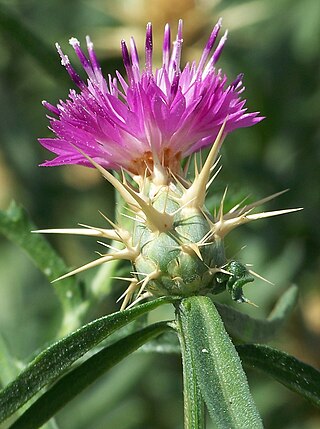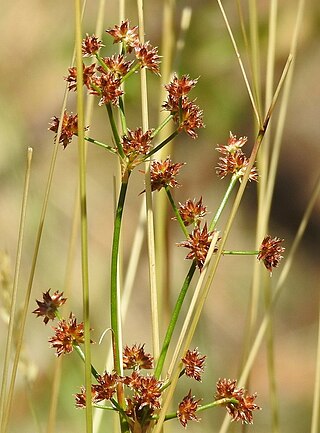
Lomelosia prolifera, the Carmel daisy, is a flowering plant of the family Caprifoliaceae. Its flowers in February to May, are creamy yellow, and when the petals are shed they leave a greenish-looking dried flower, good for arrangements. It is native to the eastern Mediterranean.

Centaurea calcitrapa is a species of flowering plant known by several common names, including red star-thistle and purple star thistle. It is native to Europe but is rarely found there, it is known across the globe as an introduced species and often a noxious weed. The species name calcitrapa comes from the word caltrop, a type of weapon covered in sharp spikes.

Euphorbia peplus, is a species of Euphorbia, native to most of Europe, northern Africa and western Asia, where it typically grows in cultivated arable land, gardens and other disturbed land.

Salvia hierosolymitana is a species of flowering plant in the family Lamiaceae. It is a herbaceous perennial commonly called Jerusalem salvia or Jerusalem sage that is native to the eastern Mediterranean, with populations in Cyprus, Israel, Jordan, Lebanon, Syria, and the West Bank. It typically grows in open fields, rocky soils, and among low-growing native shrubs. It was first described in 1853 by botanist Pierre Edmond Boissier, with the epithet "hierosolymitana" referring to "royal, sacred Jerusalem".

Veronica triphyllos is a species of flowering plant in the plantain family known by the common name finger speedwell, or fingered speedwell. It is native to Europe, western Asia and NW Africa, but introduced to some parts of the United States.
Euphorbia condylocarpa is a plant species in the genus Euphorbia.

Iris palaestina is a species in the genus Iris in the subgenus Scorpiris. It is a bulbous perennial from Asia, including the Palestine region, Lebanon, Syria and Turkey. It has long, narrow, strap-like leaves, and a short stem. The early blooming, fragrant flowers are greenish-grey/white or yellow-white.

Dianthus strictus, known as the wild pink, is a species of flowering plant in the family Caryophyllaceae.

Noaea is a genus of flowering plants belonging to the family Amaranthaceae. It is in the Salsoloideae subfamily.

Zosima is a genus of flowering plants belonging to the family Apiaceae.

Cyperus capitatus, known as Capitate Galingale is a species of sedge that is native to coasts of the Mediterranean and close by; it has no subspecies.
Euphorbia rhabdotosperma is a species of flowering plant in the Euphorbiaceae family.

Juncus heldreichianus is a large tufted species of rush in the family Juncaceae, formed of two subspecies.

Juncus fontanesii, also known as Desfontaines' rush, is a species of rush in the family Juncaceae.
Juncus littoralis is a species of rush in the family Juncaceae known as coastal rush; it has no subspecies.
Dryopteris pallida is a species of fern.
Malvella sherardiana, or Sherard's malvella, is a perennial plant native to Spain and from Greece to Crimea, southeastward to Iran, the only old world species in the genus Malvella.

Alcea digitata, the fingered hollyhock, is a tall hollyhock with large flowers native to the Middle East.
Malva unguiculata, the bryony-leaved tree-mallow, is a very tall perennial tree-mallow with large pink flowers native to the East Mediterranean.
Alcea apterocarpa is a tall hollyhock plant native to Lebanon, Syria, Palestine, the Sinai, and Turkey.













